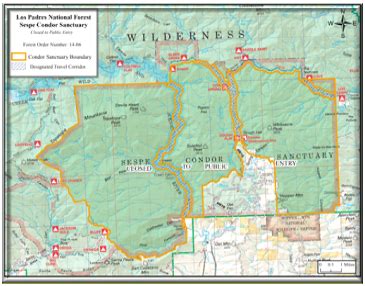The Sespe Condor Sanctuary, located in the Los Padres National Forest in California, is a haven for one of North America’s most iconic and endangered species: the California Condor. As a vital component of the condor recovery program, the sanctuary plays a crucial role in protecting these magnificent birds and their habitat. With its unique combination of rugged terrain, diverse wildlife, and dedicated conservation efforts, the Sespe Condor Sanctuary is an exemplary model of wildlife preservation and ecosystem management.
Historical Background: The California Condor’s Plight
The California Condor, once a thriving species with a range that spanned the western United States, Mexico, and parts of Central America, faced a drastic decline in population due to habitat loss, lead poisoning, and hunting. By the 1980s, only 22 condors remained in the wild, prompting the U.S. Fish and Wildlife Service to launch a comprehensive recovery program. The Sespe Condor Sanctuary, established as part of this effort, has been instrumental in providing a safe haven for these birds to thrive.
Conservation Efforts: A Multifaceted Approach
The conservation efforts at the Sespe Condor Sanctuary are multifaceted and geared towards addressing the various challenges faced by the California Condor. Some of the key initiatives include:
- Habitat Preservation: The sanctuary protects a vast area of natural habitat, including forests, grasslands, and coastal regions, which provides the condors with an ideal environment for foraging, breeding, and roosting.
- Lead-Free Program: To combat lead poisoning, a major threat to condors, the sanctuary promotes the use of non-lead ammunition among hunters and provides alternative ammunition to reduce the risk of lead contamination in the food chain.
- Condor Monitoring: A team of dedicated biologists and conservationists closely monitors the condor population, tracking their movements, behavior, and health to ensure the effectiveness of the conservation efforts.
- Education and Outreach: The sanctuary engages in extensive education and outreach programs to raise awareness about the importance of condor conservation, promote coexistence with wildlife, and inspire communities to take action in protecting these magnificent creatures.
Ecological Importance: The Role of Condors in Ecosystems
California Condors play a vital role in maintaining the ecological balance of their habitats. As scavengers, they help to dispose of carcasses, preventing the spread of disease and maintaining the health of the ecosystem. Their unique feeding behavior also contributes to the dispersal of seeds and nutrients, supporting the growth of new plant life. By protecting the condors and their habitat, the Sespe Condor Sanctuary indirectly benefits a wide range of other species that share the same ecosystem, underscoring the importance of conservation efforts for maintaining biodiversity.
Challenges and Future Directions: Ensuring the Long-Term Survival of the Species
Despite the progress made in condor conservation, several challenges remain, including the ongoing threat of lead poisoning, habitat fragmentation, and climate change. To address these challenges, the Sespe Condor Sanctuary and its partners are exploring innovative strategies, such as:
- Collaborative Research: Engaging in collaborative research projects with universities, research institutions, and other conservation organizations to better understand condor biology, behavior, and ecological roles.
- Community Engagement: Strengthening community engagement and outreach efforts to promote a culture of coexistence with wildlife and inspire collective action in condor conservation.
- Ecosystem Restoration: Implementing ecosystem restoration projects to enhance habitat quality, promote biodiversity, and ensure the long-term sustainability of the condor population.
Conclusion: The Enduring Importance of the Sespe Condor Sanctuary
The Sespe Condor Sanctuary stands as a testament to the power of dedicated conservation efforts and the importance of protecting endangered species. Through its comprehensive approach to condor conservation, the sanctuary not only safeguards the future of the California Condor but also contributes to the health and resilience of ecosystems. As we continue to face the challenges of biodiversity loss and environmental degradation, the lessons learned from the Sespe Condor Sanctuary serve as a reminder of the enduring value of conservation and the necessity of collective action in protecting our planet’s precious wildlife heritage.
What is the current population status of the California Condor?
+As of the latest census, the total population of California Condors has risen to over 500 individuals, with around 300 of these birds living in the wild. This remarkable recovery is a direct result of concerted conservation efforts, including the establishment of sanctuaries like the Sespe Condor Sanctuary.
How can individuals contribute to California Condor conservation?
+Individuals can contribute to California Condor conservation by supporting organizations involved in condor recovery programs, spreading awareness about the importance of condor conservation, advocating for policies that protect wildlife and their habitats, and making eco-friendly choices in daily life, such as choosing lead-free ammunition for hunting.
What are some of the major threats to the California Condor’s survival?
+Major threats to the California Condor’s survival include lead poisoning from ingesting lead bullets while scavenging, habitat loss and fragmentation, poaching, and climate change. Addressing these threats requires a multifaceted approach that involves government agencies, conservation organizations, local communities, and individual actions.



